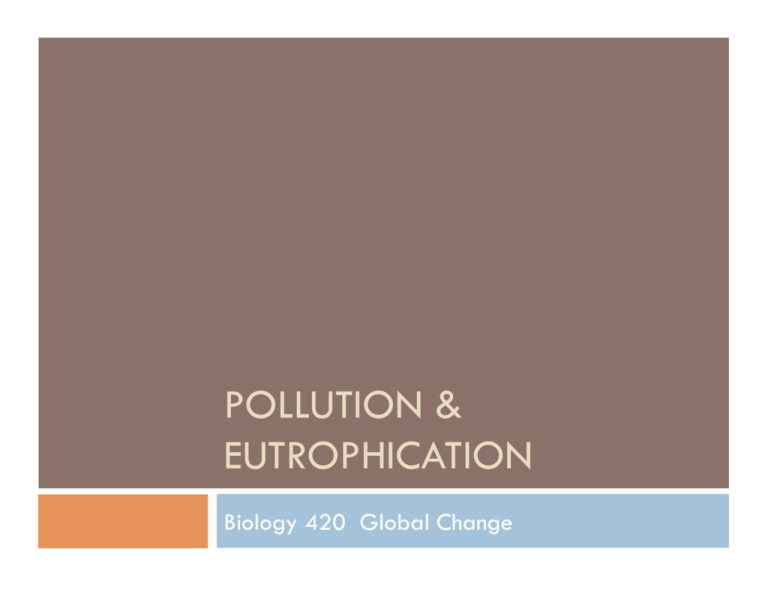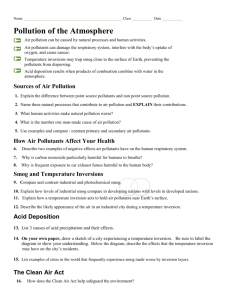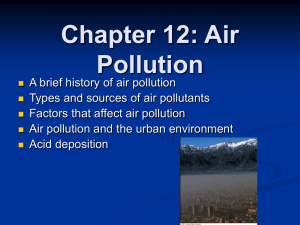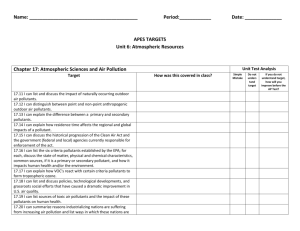pollution & eutrophication - Cal State LA
advertisement

POLLUTION & EUTROPHICATION Biology 420 Global Change Announcements Presentations/Science Brief Midterm Assignments Due today by 5pm: Acid Precipitation Homework Due next Thursday: Sea Level Rise Homework Smog Urban settings – cities As humans settle, cities grow, waste builds up Industrial revolution – burning of coal Urban air pollution – smog Airborne toxic event – London 1952 December 5-9, 1952 – British Isles capped by a large-scale temperature inversion and dense fog Pollutants accumulated in air Smog – smoke and fog Los Angeles Smog Term “smog” used to describe air pollution derived from emissions of automobiles Los Angeles – overrun by cars Emission react with sunlight to form “photochemical smog” Primary and Secondary Pollutants Primary gaseous pollutants are those that are directly emitted into the atmosphere Secondary gaseous pollutants are those that are generated in the atmosphere from primary pollutants Also, difference between gaseous pollutants and aerosols/particulates Basic Ingredients Coal-burning Smoke and organic fumes High levels of sulfur dioxide Acid precipitation Automobile exhaust Nitrogen oxides – NOx Carbon monoxide Reactive hydrocarbons Primary Pollutants Sulfur oxides (SOx) Volcanoes industrial processes – found in coal and petroleum – SO2 reacts to form sulfuric acid Nitrogen oxides (NOx) Result from high temperature combustion Brown haze Primary Pollutants cont’d Carbon monoxide (CO) Colorless, odorless, non-irritating but poisonous gas. By-product by incomplete combustion Vehicular exhaust Carbon dioxide (CO2) colorless, odorless, non-toxic greenhouse gas ocean acidification Sources include combustion, cement production, and respiration Primary Pollutants cont’d Volatile organic compounds – VOCs Two categories: methane (CH4) and non-methane (NMVOCs). Methane -greenhouse gas Other hydrocarbon VOCs are also significant greenhouse gases via their role in creating ozone and in prolonging the life of methane in the atmosphere NMVOCs - the aromatic compounds benzene, toluene and xylene are suspected carcinogens Particulate matter (PM)- PM10, PM2.5 Tiny particles of solid or liquid suspended in a gas. In contrast, aerosol refers to particles and the gas together. Sources : volcanoes, dust storms, forest and grassland fires, living vegetation, and sea spray and anthropogenic sources (~10% of total) such as burning of fossil fuels in vehicles, power plants and various industrial processes Primary Pollutants cont’d Free radicals – disease Toxic metals - lead, cadmium and copper. Chlorofluorocarbons (CFCs) – ozone hole Ammonia (NH3) Emitted from agricultural processes. Odors (various organic compounds) — such as from garbage, sewage, and industrial processes Radioactive pollutants Produced by nuclear explosions War explosives Natural radioactive decay of radon Secondary Pollutants Particulate matter formed from gaseous primary pollutants and compounds in photochemical smog. Ground level ozone (O3) formed from NOx and VOC. In stratosphere - Ozone layer In troposphere - abnormally high concentrations brought about by human activities (largely the combustion of fossil fuel), ozone is a pollutant, and a constituent of smog. Peroxyacetyl nitrate (PAN) formed from NOx and VOCs Clean Air Act Passed in 1970, amended in 1977 and again in 1990 The Clean Air Act U.S. Environmental Protection Agency sets national health-based air quality standards to protect against common pollutants including (1) Not to be exceeded more than once per year. (2)Final rule signed October 15, 2008. The 1978 lead standard (1.5 µg/m3 as a quarterly average) remains in effect until one year after an area is designated for the 2008 standard, except that in areas designated nonattainment for the 1978 standard, the 1978 standard remains in effect until implementation plans to attain or maintain the 2008 standard are approved. (3) The official level of the annual NO2 standard is 0.053 ppm, equal to 53 ppb, which is shown here for the purpose of clearer comparison to the 1-hour standard (4) To attain this standard, the 3-year average of the 98th percentile of the daily maximum 1-hour average at each monitor within an area must not exceed 100 ppb (effective January 22, 2010). (5) Not to be exceeded more than once per year on average over 3 years. (6) To attain this standard, the 3-year average of the weighted annual mean PM2.5 concentrations from single or multiple community-oriented monitors must not exceed 15.0 µg/m3. (7) To attain this standard, the 3-year average of the 98th percentile of 24-hour concentrations at each population-oriented monitor within an area must not exceed 35 µg/m3 (effective December 17, 2006). (8) To attain this standard, the 3-year average of the fourth-highest daily maximum 8-hour average ozone concentrations measured at each monitor within an area over each year must not exceed 0.075 ppm. (effective May 27, 2008) (9) (a) To attain this standard, the 3-year average of the fourth-highest daily maximum 8-hour average ozone concentrations measured at each monitor within an area over each year must not exceed 0.08 ppm. (b) The 1997 standard—and the implementation rules for that standard—will remain in place for implementation purposes as EPA undertakes rulemaking to address the transition from the 1997 ozone standard to the 2008 ozone standard. (c) EPA is in the process of reconsidering these standards (set in March 2008). (10) (a) EPA revoked the 1-hour ozone standard in all areas, although some areas have continuing obligations under that standard ("anti-backsliding"). (b) The standard is attained when the expected number of days per calendar year with maximum hourly average concentrations above 0.12 ppm is < 1. (11) (a) Final rule signed June 2, 2010. To attain this standard, the 3-year average of the 99th percentile of the daily maximum 1-hour average at each monitor within an area must not exceed 75 ppb. Water Pollution Point and Non-Point Source Point source – industry, factory at a river or the ocean Non-point – agriculture, feedlot, cropland, street runoff etc… Oxygen depletion Strong link between areas with high densities of industrial activity and zones of seasonally oxygen-depleted waters It has been estimated that about 80% of all marine pollution originates from land-based activity (rivers and atmospheric deposition) Eutrophication has been linked to the formation of ‘dead zones’ on the ocean floor. One of the largest known ’dead zones’ is found along the United States shoreline of the Gulf of Mexico, which receives large volumes of fertilizer from the Mississippi River system Eutrophication can also cause harmful algal blooms (HABs), which can harm fish and shellfish, as well as the people who consume them Seasonal oxygen depleted waters Hypoxia Dead zones (hypoxic i.e. oxygen deficient water) in the coastal zones are increasing due to nutrient pollution, in the form of nitrogen and phosphorous leading to algal blooms and eutrophication Sewage/wastewater Sewage treatment is low or absent in many parts of the World Eutrophication Algal blooms Reduced ability of coral to recover from bleaching events Biological Oxygen Demand The availability of oxygen is one of the most important indicators of the condition of a water body, because dissolved oxygen, or DO, (the amount of oxygen dissolved in water) is necessary for most aquatic organisms Some improvement in Europe Biological Oxygen Demand A chemical procedure for determining the amount of dissolved oxygen needed by aerobic biological organisms in a body of water to break down organic material present in a given water sample at certain temperature over a specific time period. Used as an indication of the organic quality of water. Expressed in mg O2/L consumed during 5 days of incubation at 20 °C (BOD5) De-Oxygenation A closed system, where you start with a concentration of O2 and your system has a BOD. The O2 will be depleted exponentially. Re-Aeration If no BOD, the O2 from atmosphere will dissolve into water to a saturation point that’s temperature dependent. Point Source Pollution – BOD Problem Oxygen Sag Curve Acid Mine Drainage Pyrite Oxidation 2FeS2(s) + 7O2 + 2H2O = 2Fe2+ + 4SO42- + 4H+ Iron Oxidation 4Fe2+ + O2 + 4H+ = 4Fe3+ + 2H2O Thiobacillus ferroxidans More Oxidation FeS2(s) + 14Fe3++ 8H2O = 15Fe2+ + 2SO42- + 16H+ Link to Cryosphere Recall the last lecture… Pollution and Polar Bears Between 20,000 and 25,000 bears globally Occur in19 relatively discrete sub-populations Top the food chain in the Arctic and thus exposed to high levels of pollutants - biomagnification. Immune system may be weaker in polar bears with higher levels of toxic contaminants (e.g., Polychlorinated Biphenyls or PCBs) PCBs- various applications: used as coolants insulating fluids for transformers and capacitors plasticizers in paints and cements stabilizing additives adhesives and more Hormone system of polar bears is affected by pollution, something that may interfere with reproduction and growth. Climate change - secondary release of toxic contaminants in melting snow, ice and permafrost






